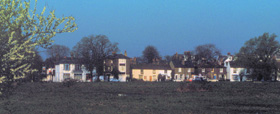History
Background to the area
The area across the Common to the west of Wimbledon Village Green has a proud history of individualism. Up until the end of the nineteenth century it was a self-contained hamlet. It consisted of five large houses with substantial grounds, a farm, two laundries, a timber yard, a shop and a group of workers cottages. It also had two pubs, a small primary and secondary school and some almshouses.
In 1871 the farsighted MP for Wimbledon, Henry Peek, sponsored an Act of Parliament to preserve the Common as open land. This prevented any further development beyond the boundaries of West Side, West Place, North View and Camp View and limited building along the lower reaches of Camp Road to private land on the south side of the road. 
The resulting enclave was an area almost unknown outside the Village and Parkside areas of Wimbledon. It tended to attract as residents individualists of one sort or another. Amongst others in the late nineteenth and early twentieth century were a campaigning feminist, an anti-vivisectionist and a theosophist group.
By the nineteen fifties and sixties, with the larger Victorian houses of North and Camp View turned into flats, the area had taken on a slightly bohemian air. It was a very mixed community. There were, amongst others, four actors, two artists, a poet, two cinematographers (one an Oscar winner), two lawyers, two journalists, a television producer, a Nobel Prize-winning scientist, an architect, a chartered surveyor, an engineer, an accountant and a senior civil servant. And finally there was a somewhat unconventional industrialist and long-time doughty fighter of any threat to the area who became, in effect, the founder of the Wimbledon Common West Residents Association. His name was Tom Springer.
NEXT : The Founding of the Association
